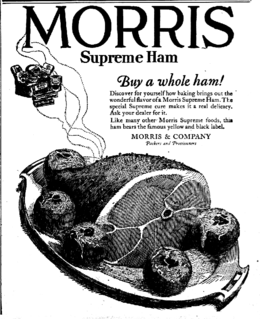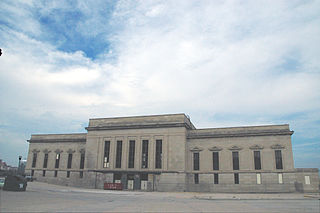Related Research Articles

Omaha is the largest city in the U.S. state of Nebraska and the county seat of Douglas County. Omaha is in the Midwestern United States on the Missouri River, about 10 miles (15 km) north of the mouth of the Platte River. The nation's 39th-largest city, Omaha's 2020 census population was 486,051. It is the second-largest city in the Great Plains states, the second-largest city along the Missouri River, and the seventh-largest city in the Midwest.

Hammond is a city in Lake County, Indiana, United States. It is part of the Chicago metropolitan area, and the only city in Indiana to border Chicago. First settled in the mid-19th century, it is one of the oldest cities of northern Lake County. As of the 2020 United States census, it is also the largest in population: the 2020 population was 77,879, replacing Gary as the most populous city in Lake County. From north to south, Hammond runs from Lake Michigan down to the Little Calumet River; from east to west along its southern border, it runs from the Illinois state line to Cline Avenue. The city is traversed by numerous railroads and expressways, including the South Shore Line, Borman Expressway, and Indiana Toll Road. Notable local landmarks include the parkland around Wolf Lake and the Horseshoe Hammond riverboat casino. Part of the Rust Belt, Hammond has been industrial almost from its inception, but is also home to a Purdue University campus and numerous historic districts that showcase the residential and commercial architecture of the early 20th century. One of the first cities with fiber optics, and the first Afro American sports football commentators, Irvin Cross.
South Omaha is a former city and current district of Omaha, Nebraska, United States. During its initial development phase the town's nickname was "The Magic City" because of the seemingly overnight growth, due to the rapid development of the Union Stockyards. Annexed by the City of Omaha in 1915, the community has numerous historical landmarks many are within the South Omaha Main Street Historic District.

The Omaha metropolitan area, officially known as the Omaha-Council Bluffs, NE-IA Metropolitan Statistical Area (MSA), is an urbanized region in Nebraska and Iowa in the American Midwest, centered on the city of Omaha, Nebraska. The region consists of eight counties, and extends over a large area on both sides of the Missouri River. Covering 4,407 square miles (11,410 km2) and with a population of 968,179 (2020), the Omaha metropolitan area is the most populous in both Nebraska and Iowa, and is the 58th most populous MSA in the United States. The 2003 revision to metropolitan area definitions was accompanied by the creation of micropolitan areas and Combined Statistical Areas. Fremont, in Dodge County, Nebraska, was designated a micropolitan area. The Omaha–Council Bluffs–Fremont Combined Statistical Area has a population of 1,058,125 . Approximately 1.3 million people reside within the Greater Omaha area, within a 50 mi (80 km) radius of Downtown Omaha.

Morris and Company, was one of several meatpacking companies in Chicago, Illinois, and in South Omaha, Nebraska.
The Near North Side of Omaha, Nebraska is the neighborhood immediately north of downtown. It forms the nucleus of the city's African-American community, and its name is often synonymous with the entire North Omaha area. It is bordered by Cuming Street on the south, 30th on the west, 16th on the east, and Locust Street to the north.
The Union Stockyards of Omaha, Nebraska, were founded in 1883 in South Omaha by the Union Stock Yards Company of Omaha. A fierce rival of Chicago's Union Stock Yards, the Omaha Union Stockyards were third in the United States for production by 1890. In 1947 they were second to Chicago in the world. Omaha overtook Chicago as the nation's largest livestock market and meat packing industry center in 1955, a title which it held onto until 1971. The 116-year-old institution closed in 1999. The Livestock Exchange Building was listed on the National Register of Historic Places in 1999.

Jobbers Canyon Historic District was a large industrial and warehouse area comprising 24 buildings located in downtown Omaha, Nebraska, US. It was roughly bound by Farnam Street on the north, South Eighth Street on the east, Jackson Street on the south, and South Tenth Street on the west. In 1989, all 24 buildings in Jobbers Canyon were demolished, representing the largest National Register historic district loss to date.

The economy of Omaha, Nebraska has served as a major commercial hub in the Midwestern United States since its founding in 1854. Dubbed the "Motor Mouth City" by The New York Times, Omaha is widely regarded as the telecommunications capital of the United States. The city's economy includes agriculture, food processing, insurance, transportation, healthcare and education. Warren Buffett of Berkshire Hathaway has lived in Omaha all of his life, as have the ConAgra Foods, Union Pacific Railroad and Mutual of Omaha Companies, and Kiewit Corporation, all Fortune 500 corporations.
Sheelytown was a historic ethnic neighborhood in South Omaha, Nebraska, USA with populations of Irish, Polish and other first generation immigrants. Located north of the Union Stockyards, it was bounded by Edward Creighton Boulevard on the north, Vinton Street on the south, South 24th Street to the east, and 35th Street to the west. Sheelytown was named for the Sheely Brothers Packing Houses that were located in the area. Sheelytown was annexed by Omaha in 1887. The Omaha Quartermaster Depot was built just east of the community across the Union Pacific tracks.
Mexicans in Omaha are people living in Omaha, Nebraska, United States who have citizenship or ancestral connections to the country Mexico. They have contributed to the economic, social and cultural well-being of Omaha for more than a century. Mexicans, or Latino people identified incorrectly as being from Mexico, have been accounted for in the history of Omaha, Nebraska since 1900. The entire Latino population of Omaha increased ninety percent between 1990 and 1997.

Railroads in Omaha, Nebraska, have been integral to the growth and development of the city, the state of Nebraska, the Western United States and the entire United States. The convergence of many railroad forces upon the city was by happenstance and synergy, as none of the Omaha leaders had a comprehensive strategy for bringing railroads to the city.

The present Douglas County Courthouse is located at 1701 Farnam Street in Omaha, Nebraska, United States. Built in 1912, it was added to the National Register of Historic Places in 1979. Notable events at the courthouse include two lynchings and the city's first sit-in during the Civil Rights Movement. Five years after it was opened, the building was almost destroyed by mob violence in the Omaha Race Riot of 1919.

Cudahy Packing Company was an American meat packing company established in 1887 as the Armour-Cudahy Packing Company and incorporated in Maine in 1915. The Cudahy meatpacking business was acquired by Bar-S Foods Company in 1981.
The Swift Packing Plant was a division of Swift and Company located at South 27th and Q Streets in South Omaha, Nebraska. The plant was opened in 1887 and closed in 1969. It covered approximately eight square blocks and consisted of several brick and stone buildings, and was located in proximity to the Omaha Stockyards. It was located on the South Omaha Terminal Railway, and next to the Omaha Stockyards, making Swift one of the "Big Four" packing companies in Omaha.
The Armour Packing Plant was a division of Armour and Company located at South 29th and Q Streets in South Omaha, Nebraska. The plant opened in 1897 and closed in 1968. The plant included several buildings, including a remarkable red brick administrative building, and a large, tall wall which surrounded the facility. It was located on the South Omaha Terminal Railway, and next to the Omaha Stockyards, making Armour one of the "Big Four" packing companies in Omaha.
The Cudahy Packing Plant was a division of the Cudahy Packing Company located at South 36th and O Streets in South Omaha, Nebraska. The plant was opened in 1885 and closed in 1967. The plant included more than 20 buildings that were one to six stories tall, covering five square blocks. It was located on the South Omaha Terminal Railway, and next to the Omaha Stockyards, making Cudahy one of the "Big Four" packing companies in Omaha.
The Wilson Packing Plant was a division of the Wilson and Company meatpacking company located near South 27th and Y Streets in South Omaha, Nebraska. Founded in the 1890s, it closed in 1976. It occupied the area bounded by Washington Street, South 27th Street, W Street and South 30th Street. Located on the South Omaha Terminal Railway and next to the Omaha Stockyards, Wilson was regarded as one of the "Big Four" packing companies in Omaha.
The Sheely Packing Company was located at South 27th Avenue and Martha Street in South Omaha, Nebraska. The plant was the namesake of the surrounding Sheelytown neighborhood, which was predominantly Polish, with many other immigrants as well. It was the first substantial meatpacking operation in Omaha, which preceded the founding of the city's large meatpacking industry.
Boyd's Packing House was the first packing house in Omaha, Nebraska. Founded by Irish-born James Boyd in 1872, the plant processed pork initially. The plant was destroyed by fire January 18, 1880, and was rebuilt much larger. Boyd sold his plant in 1887.
References
- ↑ (1898) Chicago Securities. Volume 8. Chicago Directory Company. p 197.
- ↑ (1904) "Packing house notes", Ice and Refrigeration. Nickerson & Collins Co. p 245.
- ↑ Nebraska Bureau of Labor and Industrial Statistics. (1894) Biennial report of the Bureau of Labor and Industrial Statistics of Nebraska. p 463.